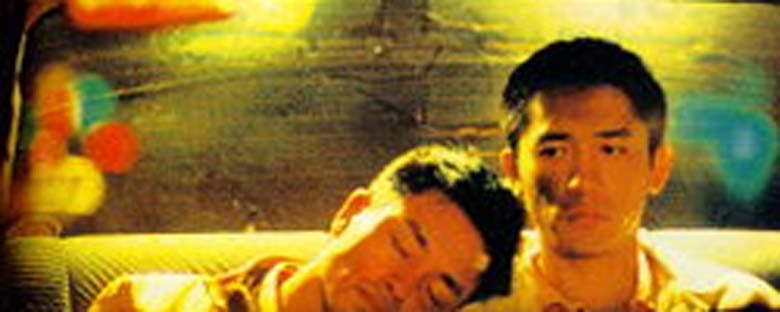Reviews
Cheun gwong tsa sit
Wong Kar-wai
Hong Kong, 1997
Credits
Review by Leo Goldsmith
Posted on 21 January 2005
Source Kino DVD
Related articles
Reviews: As Tears Go By
Reviews: Days of Being Wild
Reviews: Chungking Express
Reviews: Fallen Angels
Reviews: 2046
Happy Together is Wong Kar-wai’s melancholy postcard from Buenos Aires, a vibrant, painful, and deeply nostalgic “wish you were(n’t) here” from two uprooted immigrants yearning for emotional security, for their homeland, and for each other.
The film follows the torturous, masochistic relationship between two men, Lai Yiu-fai and Ho Po-wing, as they struggle for economic and emotional stability in the portside neighborhood of La Boca (photographed by Christopher Doyle in all its fluorescent dreariness). In the confines of the tiny apartment they share, the two men vie with each other in a volatile relationship marked by intense passion and violent disputes, locked in a cycle of bitter break-ups and hopeful gestures of reconciliation and “starting over.” Beautifully portraying this circular love affair are the two quintessential performances by Leslie Cheung (as the puckish, chain-smoking Po-wing) and Tony Leung (as the morose, chain-smoking Fai).
Unlike many of Wong’s films, Happy Together follows the events of the story in a linear chronology that is all but totally coherent. Fai’s voiceover narration leads the audience through the first portion of the film, detailing the sequence of the couple’s break-up and their eventual reconciliation when Po-wing is violently attacked and badly injured. (This reconciliation is denoted by the film’s shift from black and white to color film stock.) Desperate for emotional reciprocation, Fai nurses Po-wing back to health in his dingy apartment. He eventually tries to control Po-wing, trapping him in the tiny apartment and stealing his passport so that he cannot leave Argentina. This marks their return to the familiar cycle of sex and bickering, though for Fai, these are their “happiest days together.”
Romantic relationships in Wong’s films are nearly always portrayed as circular, repetitive, and obsessive, but Happy Together offers a way out for its characters, a linear move forward from the cycles of love and hate. This is structurally represented in the shift in the voiceover from Fai to Chang, a cook in the Chinese restaurant in which Fai works and with whom he develops a close (and possibly romantic) relationship. The appearance of Chang in the narrative offers Fai the possibility of actually starting over and not returning to the same masochistic cycles of his love for Po-wing.
Structurally and thematically, Happy Together is a film of mental and emotional antipodes, beginning in Argentina and ending (on the other side of the world) in Taipei. The film opens with Caetano Veloso’s wistful performance of “Cucurrucucu Paloma” (which he reprised for Almodóvar in Talk to Her) over soupy, green aerial photography of Iguaz√∫ Falls, located on Argentina’s northern border with Brazil and Paraguay; it concludes with the icy blue seascapes of Ushuaia, “the end of the world” at the tip of the southern cone, and with the cluttered neon nightlife of Liao Ning night market. Similarly, even when happy together, the film’s characters seem at opposite ends of the earth.
We don’t do comments anymore, but you may contact us here or find us on Twitter or Facebook.



